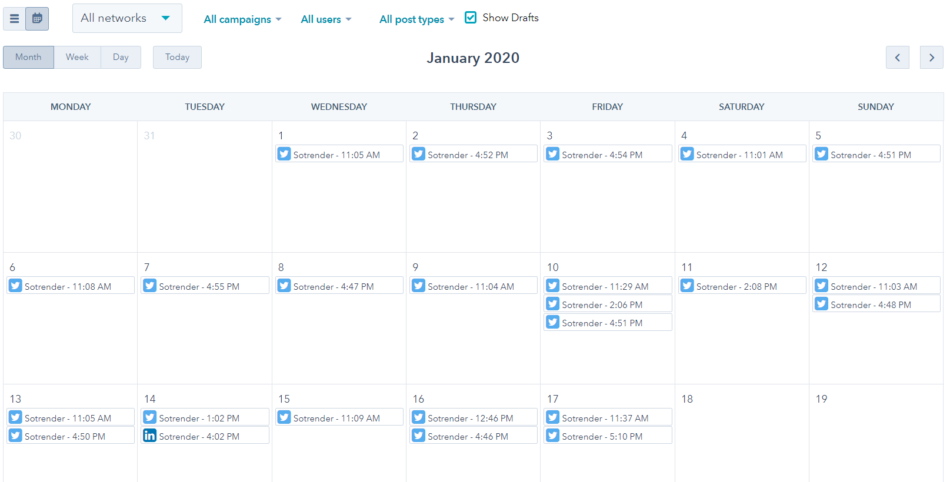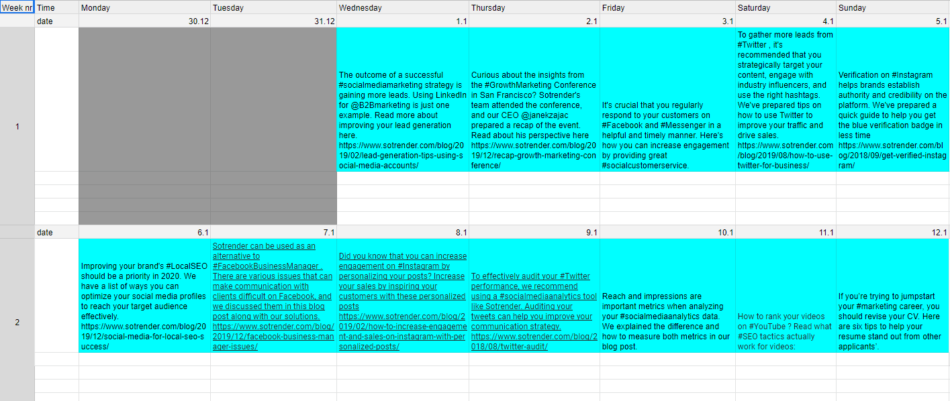Governments across the world are responding to the COVID-19 pandemic by urging people to stay at home. That means that most of us working in agencies or SaaS companies have gathered our office equipment and set up a temporary home office until further notice.
Based on our own experience, we’ve thought of some tips and recommendations that other teams could benefit from. Here’s what we’ve learned about managing social media in a team of marketers while working from home, whether due to the COVID-19 situation or an office remodel.
Working remotely as a marketer
Despite the introverts of the world feeling relieved that they can work remotely, others are not as excited. The majority of social media managers, marketers, and PR consultants don’t tend to work remotely. This situation looks like quite the challenge for creative folks who like to talk things out in person.
According to a study on 887 marketers in the UK, 62% think that their organization is going to be negatively impacted because they have to work remotely. Unsurprisingly, 68% say that it will impact creative collaboration (an especially important component of marketing work). They are mostly worried about accessing data, coordinating campaigns, and whether their contractor management will be affected.
What’s more, we should remember that as social media managers and marketers, we spend most of our time online. It’s unlikely that you will have to completely change your strategy.
Luckily, there are measures that every agency or marketing team can take to improve their situation. We’ll also go over some of the ways we’re adapting our routines and tasks so that we can successfully collaborate.
Secure your internet connection
Before you head home with your work computer, it’s crucial that you make sure you have everything you need to successfully access your projects. Those of us working in the EU know that data protection is a serious issue. This is exactly why you need to have access to a VPN that’s handled by your company’s IT department.
A virtual private network (VPN) enables you to connect to a private or public network in a safe manner. Using a VPN will allow you to:
- Transfer and access sensitive data
- Access applications and resources that are otherwise only available by connecting to your company’s network at the office
- Browse websites without your data and activity being tracked (identifying features, location, search history)
Setting up a VPN is straightforward. Once your IT department has installed the software, you just need to enter your login credentials and you’re good to go.
Do you have all of the necessary tools and apps for working remotely? We’ve prepared a list of tools that will help you coordinate better with your team.
Designate a workspace
Once you have all the right programs, you can create a comfortable workspace. It’s not just about having a tidy desk, you need to consider the environment and conditions of how you work.
You should keep a few things in mind:
- Get comfortable furniture. You’re going to be sitting in the same spot for several hours. It makes sense to invest in ergonomic chairs to support your spine.
- Maintain good sleep hygiene by working and sleeping in different rooms. For studio flats, just make sure there’s enough space between your work and sleep environment.
- Mimic your routine. If you’re used to getting a beverage before starting your tasks, then do it! Get out of your pajamas, and take those “water cooler” breaks. Get up, walk around, maybe set up a quick call with your coworkers so you have the same rhythm.
- Establish your work hours and boundaries. If you’re doing more work outside of your work hours, you’re going to end up stressed. Remember, we’re in the middle of a pandemic, and working from home =/= working any time. Take the time you need to care for your mental and physical health. If you need to reach a coworker, empathize with their need for a clearer work-personal life boundary at this time.
- Take breaks away from your screen. Your back will start to hurt, and your eyes will become irritated from all that blue light.
Since we’re not freelancers, we need to set up some general rules about the time we’ll be available. We recommend establishing a time slot where everyone in the company should be available. At Sotrender, our rule is that everyone should be reachable between roughly 10 am and 4 pm. That allows us to communicate effectively with our coworkers who start work at 7 am as well as 9 am.
Even if you’re not spending time commuting every day to work, you should still be mindful of other people’s time. It’ll help maintain the same productivity and respect that you’d have in an office setting.
It’s one thing to get lunch or to take a break from your screen for a bit of time. Just give your team a heads up if you’re going to be gone for a while. Some tasks are time-sensitive so keep that in mind.
Set up a schedule
One of the best ways to visualize your plans for the month is to use a content calendar. It’s useful when you are trying to plan posts, social media copy, email campaigns, or any other form of communication.
However, we’re aware that money might be tight right now given the COVID-19 pandemic, so you might not have the resources to pay for a scheduling tool. Don’t worry, you can actually make your own content calendar for free. All you need is a Google Docs spreadsheet and some color-coding. Here’s how we’ve done it, it doesn’t have to be anything fancy. 😉
We try to update our calendar once a week or once every two weeks. If you get inspiration for new posts, you just need to make minor adjustments. You can also adjust your content strategy based on how your audience is engaging certain posts. So remember to analyze how your content is performing over time. 😉
Alternatively, you can use paid-for calendars such as Coschedule or the social calendar in HubSpot. Both of these tools are reliable, though you need to learn how to correctly modify your posts so that they appear as you wanted. Save time on opening every social media profile on a daily basis and use them to schedule social media posts on Facebook, Twitter, Instagram, and LinkedIn.

Marketing stand-ups
It was much easier when we could give each other face-to-face updates and ask for opinions while completing our tasks. Thankfully, Google Hangouts and Zoom are here to help.
From experience, our marketing team benefits from scheduling a call or doing daily stand-ups. Even though everyone is working from home, we’re trying to stay on the same page with small updates. Try to maintain the same vibe you have at the office, including the social aspect.
Need to facilitate a remote brainstorming session? Use Canva Whiteboards if you like an infinite digital whiteboard with lots of stickers, templates, sticky notes, and ready-made graphs. Plus, it has a built-in timer tool, so you can keep brainstorming workshops short and sweet.
The question that comes up somewhat regularly is whether or not you should turn on your camera during meetings. Do you absolutely need to turn your camera on to have a productive meeting? Opinions seem to be mixed. Some think you should make every meeting a video call while others are taking a more laid-back approach.
If you decide to do a video call, it’s worth reading up on video call etiquette. If you’re going to have a video conference call, make sure you mute yourself when you’re not speaking, keep a clean background (or use a virtual background on Zoom).
When it comes to frequency, it’s not necessary to have a video conference every day. Our experience is that once every few days is enough.
Keep up with social media trends
It’s crucial that you stay up-to-date with what people are posting on social media, blogs, and other media. To save you time, we gathered some ideas for content creation during the pandemic.
For example, Agency Drive has been posting content related to the pandemic and working remotely. They’re encouraging others to use social media for good and encourage others to take care of their health. They’re also sharing moments from their conference calls to normalize the habit of working from home.
Remember, as a social media manager, knowing what’s happening on social media is your job. Don’t feel so guilty about spending more time on social media. Try to gather good examples, and think of ways that you can incorporate them into your content strategy.
Socialize with your coworkers
You should all be checking up on each other. Are your teammates staying safe and healthy? Do they have the support they need? It’s easy to get demoralized when you’re isolated.
It’s still possible to boost team morale and maintain a sense of normalcy to some extent. Some companies are still throwing integration and end-of-the-month parties at a distance. If you pretty much live on Instagram or Facebook, chances are that your Stories are filled with people having Zoom, Skype, or Messenger calls. Why not hop on that bandwagon? 🙂
We recently had a company-wide event for Easter at Sotrender. We played JackBox Party Pack games and used Whiteboard to draw a card for Easter together. It didn’t require too much planning, and it was easy enough to set up using Twitch and Google Meet. Here’s how our masterpiece turned out.
Another recommendation would be to create a separate channel for light-hearted entertainment. We have a channel on Google Hangouts where we share memes, comics, and other entertaining posts. It’s just one of the ways that you can try to ease the tension and feel better temporarily.
Finally, you could have an active video or voice call for the entirety of the day. That way, anyone who wants to chat can join in, if only for a few minutes. You won’t have to create a room every time, it’ll always be available to whoever has the time or need to socialize. If you’re using Google Meet, schedule a call like you would for a company-wide meeting. All anyone has to do is just click on the link to join.
Working remotely doesn’t have to be detrimental
To sum up, it’s possible to work from home and successfully collaborate with your marketing team. If you spend most of your time creating and planning content for social media, chances are you’ll adapt rather quickly. Be considerate of your own and your coworkers’ needs at this dynamic and uncertain time.
Do you have any other ideas for adjusting to managing your marketing team from home? Let us know in the comments!







